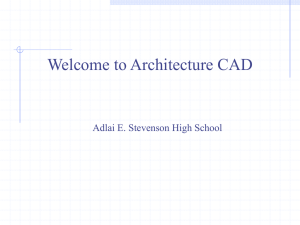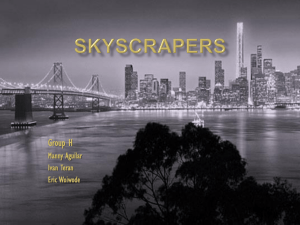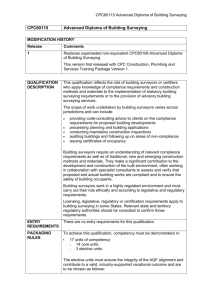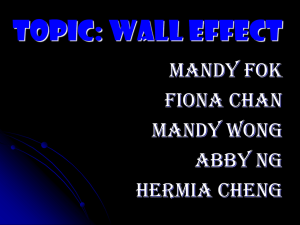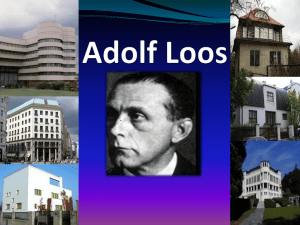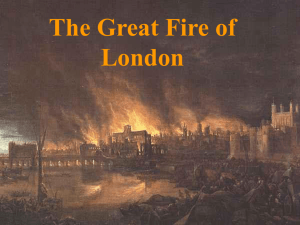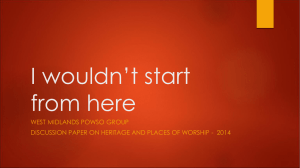ENG 205 (CENG, ECE, MCS dept.s)
advertisement
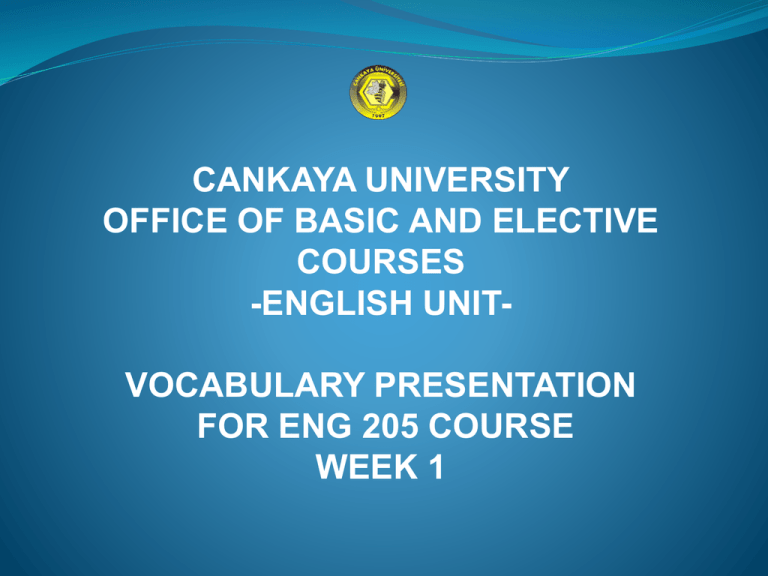
CANKAYA UNIVERSITY OFFICE OF BASIC AND ELECTIVE COURSES -ENGLISH UNITVOCABULARY PRESENTATION FOR ENG 205 COURSE WEEK 1 FORM AND FUNCTION UNIT 1 CANKAYA UNIVERSITY - OFFICE OF BASIC AND ELECTIVE COURSES- ENGLISH UNIT Form follows function… Have you ever heard the phrase “form follows function?” What does it mean? -It means the way something looks should be determined by its purpose. Have you really thought about what it implies about architecture? CANKAYA UNIVERSITY - OFFICE OF BASIC AND ELECTIVE COURSES- ENGLISH UNIT Form follows function… Form follows function is a principle associated with modern architecture and industrial design in the 20th century. The principle is that the shape of a building or object should be primarily based upon its intended function or purpose. The American architect Louis Sullivan, mentioned the phrase “Form follows function” in his article The Tall Office Building Artistically Considered in 1896. According to Sullivan, the shape and organization of a building should be determined only by functional requirements. This is the famous Wainwright Building (also known as the Wainwright State Office Building) by Louis Sullivan. It is described as “a highly influential prototype of the modern office building”. When people look at this building, they can understand that it is an office building. So, shape of the building is parallel with its function. Sullivan said that “form follows function”, but does it really? Can you tell whether a building is a theater, a library, or a museum just by looking at the outside? In a research study at Ohio State University, 160 people from three distant cities were shown pictures of buildings and asked to guess the purpose of those buildings. Most people couldn’t. Could you? Now, look at the pictures of some buildings and try to guess the purpose of them… Guggenheim Museum, New York Sydney Opera House Hotel Sofitel, in Tokyo Designed by architect Orlando De Urrutia. It looks like a water droplet falling from the sky. The Water Building Resort seeks to be the first building in the world to generate pure drinking water from the atmosphere using solar power. The Water Building Resort in Spain Stata Center is an academic complex designed by architect Frank Gehry for the Massachusetts Institute of Technology. (In the building there are the Computer Science and Artificial Intelligence Laboratory, the Laboratory for Information and Decision Systems, as well as the Department of Linguistics and Philosophy.) Guggenheim Museum in Bilbao Spain Dancing House in Prague by Vlado Milunić and Frank Gehry Gasometer B in Vienna (In Gasometers indoor facilities include a music hall, movie theatre, student dormitory, and so on... ) Plaza de castilla, Madrid The crooked house in Sopot, Poland (a shopping center) Answer Key Exercise I: Answer the questions. (p.2) 1.What does “form follows function” mean? It means the shape of a building or object should be primarily based upon its intended function or purpose. 2. Why did the researches show different photographs of different buildings to people? What was the result? To see if people can identify the function of a building looking at its shape. Only 32% of the people in the study chose correctly. 3. Why do some researches believe that form should follow function? If buildings clearly show their purpose, visitors can more easily find their way, and city life becomes more comfortable and understandable for everyone. Ex.1(p. 2) 4. Do you think it’s important for architects to design buildings that indicate their use? 5.Look at the photos of San Francisco Art Museum and the Seattle Public Library on the previous page. Both of these buildings have a serious purpose. Why do you think the architects designed these buildings in this way? Answer Key Exercise II: Label the pictures below with these adjectives of shape. (p. 2) curved cylindrical vertical horizontal 1. inclined tapered oval rectangular elliptical 2. CURVED 3. TAPERED OVAL curved cylindrical vertical horizontal 4. inclined tapered oval rectangular elliptical 5. HORIZONTAL 7. 6. RECTANGULAR 8. INCLINED ELLIPSE 9. VERTICAL CYLINDRICAL Exercise III: In pairs, take turns to describe each building briefly (without naming or identifying it). (p. 3) A) The Hearst Tower B) Capital Gate C) The Swiss Re Building Exercise V: Correct the false information in these statements. (p.3) - Answer Key 1. The Hearst Tower has by far the most extensive (or greatest) floor area of the three buildings, and is also the tallest and has the largest number of storeys. The floor plan is th closest to a rectangular shape. The top of the tower is the most (least) tapered (or pointed) of the three. 2. Capital Gate has the fewest storeys, and easily the shortest of the three towers, with the least extensive floor area. It has the most curved shape of the three, and is the most inclined (or leaning) from the vertical. 3. The Swiss Re Building has the most conical overall shape, and the most circular floor plan of the three. The narrowist point is at the top of the tower, and the widest part is at the base (16th floor). It is the least tall of the three buildings and has the fewest storeys and the least extensive floor area. Exercise V: Correct the false information in these statements. (p.3) - Answer Key 1. The Hearst Tower has by far the most extensive (or greatest) floor area of the three buildings, and is also the tallest and has the largest number of storeys. The floor plan is the closest to a rectangular shape. The top of the tower is the wrong: most (correct:least) tapered (or pointed) of the three. 2. Capital Gate has the fewest storeys, and easily the shortest of the three towers, wrong: with the least extensive floor area. It has the most curved shape of the three, and is the most inclined (or leaning) from the vertical. 3. The Swiss Re Building has the most conical overall shape, and the most circular floor plan of the three. The narrowist point is at the top of the tower, and the widest part is at the wrong: base (correct: 16th floor). It is the least tall of the three buildings and has wrong:the fewest storeys and the least extensive floor area. Answer Key Exercise VI: Read the descriptions. Write the description number next to the picture. (p. 4) Burj Khalifa 4. This building is likely to remain the tallest building in the world for many years. The Y-shaped base gives the structure great stability. The lower part of the building provides 160 floors for human occupation. The top 46 levels of the thin, pointed spire are for maintenance and services only. Taipei 101 3. For a time, this was the tallest building in the world. It has an unusual shape: eight tapering sections rest upon a huge base or pedestal, which also tapers upwards from the ground floor, which is in the shape of a square. Shangai World Financial Centre 1. The base of the building is square, but for three quarters of its height, it tapers to its recognizable rectangular top, where an opening reduces the stresses of a wind pressure. Its shape is often compared to a giant bottle-opener. The hotel on the 79th to 93rd floors is the highest in the world. Petronas Towers 2. When this building was completed in 2004, it was the highest in the world. The towers remain the tallest twin towers in the world. The two spines at the top of the building, which are not antennas, form part of the structure. The towers are linked by a two-storey sky bridge linking the 41st and 42nd floors. OPTIONAL TASK (p. 4) B C A D In pairs, talk about the shapes of the buildings in the picture.
